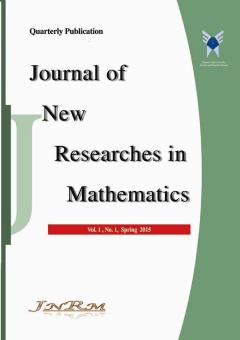ارزیابی شرکت های هواپیمایی ایران با ساختار شبکه دو مرحله ای DEA فازی
Subject Areas : تحقیق در عملیات
سمیه صادق زاده
1
,
محمدرضا مظفری
2
![]() ,
زهره ایروانی
3
,
علی ابراهیم نژاد
4
,
هادی باقرزاده ولمی
5
,
زهره ایروانی
3
,
علی ابراهیم نژاد
4
,
هادی باقرزاده ولمی
5
1 -
2 -
3 -
4 -
5 -
Keywords: رویکرد تابع احتمال فازی, تحلیل پوششی داده ها, شبکه DEA, برنامه ریزی خطی فازی,
Abstract :
Today, it is very important to evaluate companies and organizations that have a multi-level network structure. In the aviation industry, paying attention to the multi-stage structure can be very important due to the importance of the visa at each stage and preventing accidents and unpleasant events. In this article, based on the fuzzy probability function approach, a two-stage network model is proposed in data envelopment analysis. First, the efficiency calculation models in the first and second stage of the fuzzy network are proposed and we use the probability function approach to de-phase the models, then the comparison of the efficiency of the first stage, the second stage and the overall stage is presented based on the two-stage network model, and in The completion of the comparison of efficiencies based on alpha-cuts in the fuzzy network of 16 Iranian airlines is investigated. At the end of the study, an application with fuzzy tens is presented.
[1] M.J Farrell,.(1957). The measurement of productivity efficiency. Journal of The Royal StatisticalSociety Series A: General 120, (3), 253–281.
[2] A.,Charnes, Cooper, W. W., Rhodes, E., (1978). Measuring the efficiency of decision makingunits. European Journal of Operational Research , 2, 429-444
[3] R, Banker,. D., Charnes, A., Cooper, W. W., (1984). Some models estimating technical and scaleinefficiencies in data envelopment analysis. Management Science, 30, 1078-1092.
[4] , J.L.Verdegay, Delgado, ,M. and M. A. “A general model for fuzzy linear programming”, FuzzySetsand Systems 29 (1989) 21-29.
[5] C.L. Hwang., Y.J. Lai and Fuzzy Mathematical Programming Methods and Applications, Springer,Berlin, 1992
[6] N.Mahdavi-Amiri, , and Nasseri, S.H. , Duality results and a dual simplex method for linear programming problems with fuzzy variables, Fuzzy Sets and Systems, 158 (2007) 1961-1978.
[7] S.H.,Nasseri, , and A. Ebrahimnejad, A fuzzy primal simplex algorithm and its application for solving the flexible linear programmingproblems, European ournalof Industrial Engineering, 4(3) (2010) 372- 389.
[8] K .Govindan, A. Jafarian, , V.Nourbakhsh, , 2015. Bi-objective integrating sustainable order allocation and sustainable supply chain network strategic design with stochastic demand using a novel robust hybrid multi-objective metaheuristic. Comput. Oper Res.62,112–130. http : // dx . doi . org /1 0.1016
[9] A. Ebrahimnejad,. M Tavana,., Lotfi,., F.H .Shahverdi, R., Yousefpour, M., 2014. A three-stage Data envelopment Analysis model with application to banking industry. Measurement 49, 308–319.
[10] S.H. Nasseri, ,-A New Approach to Solve Fully Fuzzy Linear rogramming with Trapezoidal Numbers singConversion Functions-Received Summer 2015, Accepted Autumn 2015- Available Online at http://jnrm.srbiau.ac.ir-Vol.1, No.3, Autumn 2015.
[11] R. Färe, & Grosskopf, S. (1997). Intertemporal production frontiers: with dynamic DEA. Journal of the operational research society, 48(6), 656-656.
[12] C Kao, Liu ST (2011) Efficiencies of two-stage systems with fuzzydata. Fuzzy Sets Syst 176(1):20–35
[13] C. Chen and H. Yan, Network DEA model for supply chain performance evaluation, Europeanjournal of operational research, 213 (2011), 147-155.
[14] C. Kao, Network data envelopment analysis: A review, European journal of operationalresearch, 239 (2014), 1-16.
[15] D. K. Despotis, G. Koronakos, D. Sotiros,Compositionversus decomposition intwostage network DEA: a reverse approach,Journal of Productivity Analysis 45 (2016)71-87. http : // dx . doi . org / doi.org/10.1007/s11123-014-0415-x/
[16] K. Chen, , & J. Zhu, (2017). Second order cone programming approach to two-stage network data envelopment analysis. European Journal of Operational Research, 231– 262(1),
[17] H.Pourbabagol, A., Maghsod, , Hanafizadeh,P,. (2023). A new fuzzy DEA network based on possibility and necessity measures for agile supply chain performance evaluation: A case study. Expert Systems with Applications, 220,119552
[18] S. Tavassoli, Saeedeh Ketabi, S.,Mahsa Ghandehari,.M,. (2022). A novel fuzzy network DEA model to evaluate efficiency of Iran’s electricity distribution network with sustainability considerations. Sustainable Energy Technologies and Assessments, 52, 102269.
[19] Y Chen , J Du, H. David Sherman, Joe Zhu , DEA model with shared resources and efficiency decomposition, European Journal of Operational Research 207 (2010) 339–349
[20] A. Charnes, W.W. Cooper, Chance-constrained programming, Manage. Sci. 6 (1959) 73–79.
[21] S Ostovan , M. R. Mozaffari, , Jamshidi, A.& Gerami, J., Evaluation of Two-Stage Networks Basedon Average Efficiency Using DEA andDEA-R with Fuzzy Data, International Journal of Fuzzy , Systems , ISSN 1562 -24 79


